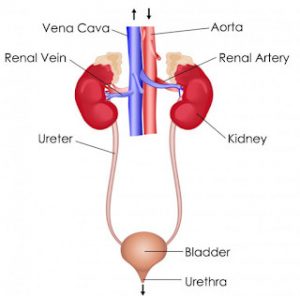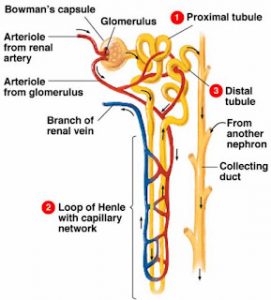Question 1 Define the term excretion?
Question 2 Where are two kidneys located in human being?
Question 3 What is transpiration?
Question 4 Name the excretory unit of kidney?
Question 5 Where is urine carried through ureters?
Question 6 what are the vital functions of kidneys?
Question 7 What is the function of blood capillaries surrounding the nephron?
Question 8 What is urethra?
Question 9 With the help of diagram describe the excretion in human being?
Excretion

Excretion is a biological process by which an organism get rid of excess or toxic waste products of metabolism.
Excretion removes unwanted by-products of metabolism, toxic chemical substances, regulate the ionic concentration of body fluids, regulates water content of body, regulate pH of body fluids.
Excretion in human being
Excretory system consist of Pair of kidney, pair of ureters, urinary bladder, urethra.
Kidney:2 kidneys are located in the abdomen, one on either side of backbone. Left kidney is larger and higher than right kidney.
Urine produced in the kidney passes through the ureters into urinary bladder where it is stored until it is released through urethra.
The function of kidney is filtration of blood to excrete the waste products of metabolism. The kidney filters about 190 litres of blood to produce 0.9-2 l of urine daily.
Structure of Nephron

Filteration is possible because walls of glomerular capillaries and Bowman’s capsule are very thin and selectively permeable.
Thus membrane allow only small molecules and water in the blood to pass through them.
Once the waste is filtered out, the blood free from waste goes into renal vein from where it goes into heart through posterior vena cava.
The fluid containing waste material is forced out of glomerular capillaries in the Bowman’s Capsule. The filtered out fluid is called Glomerular Filtrate.
Bowman’s Capsule leads to a long tubular structure before meeting collecting duct. During the flow of glomerular filtrate in this long tube, reabsorption of useful material take place.
The fluid reaching the end of collecting duct is called urine.
Finally the urine moves through ureter and collects in the urinary bladder till thrown out of body.
Excretion in Plants
The major waste substances produced by plants are oxygen, carbon dioxide and water.
They can get rid of excess water by transpiration. Many of the toxic waste products are stored within dead permanent tissue which are removed periodically.
Waste products are stored in leaves which may fall off.
Some waste products such as latex, gum, resins are stored in old Xylem.
Thnks fr the help it was really worth reading it
Where are answer of above questions. Plz provide its answer.
Answers are within the content.
It is easy to understand
Hope u will write all lesson summaries
Very good best for cbse students.
i like it
Nice work it is very helpfull
Mam, really thanks your notes helped me a lot .
Thank for your notes it really awesome
Thanks alot mam . It really helps me to understand this topic in short and also for these very important notes
Wonderful explanation which is very easy to understand….Thank u for giving us this kind of explanation
Mam it was really nice notes for CBSE student’s.
Please carry on mam.
Thanks mam for helping us.
Thanks mam for helping us in this crona virus pandemic.
Thank’s for this website
It helps me a lot to know about the excretion
Nice, keep helping students.
Thanks for these website
Good for studying in this app very nice app
Awesome!! The answer is good for making notes. Though I have not written the whole as it is but I took help from it and the answer was best in view of my science teacher. Thank you ma’am for all your help. ☺
Mam I really want these type of notes thank you
It’s very nice notes
Best notes for cbse students. It is very helpful. A lot of
This notes are best for teaching and learning.thanks for these important notes
These notes are excellent for board